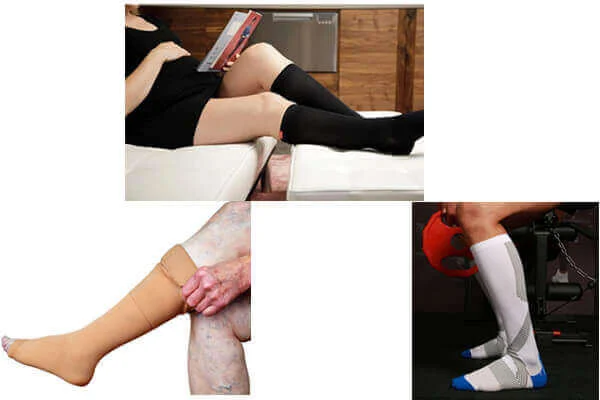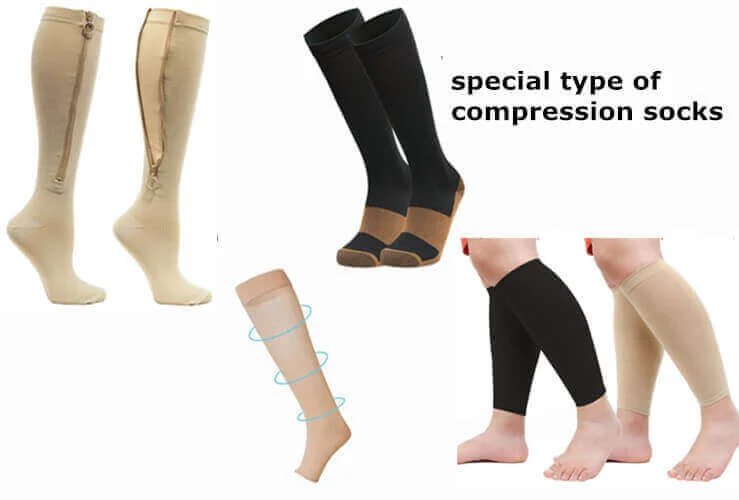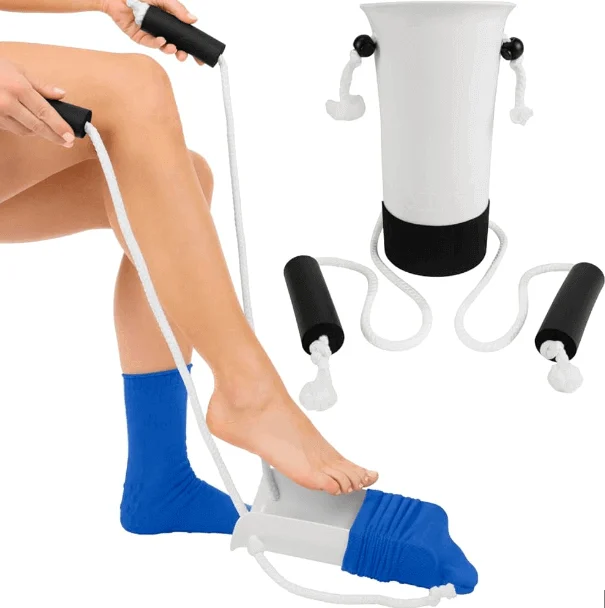
Compression socks, once considered as medical garments, now are becoming common in daily life. Whether it is for enhancing athletic performance, improving comfort during travel, or addressing health issues, these socks offer multiple benefits. They work by applying graduated pressure to stimulate blood flow and reduce swelling or fatigue. As compression socks become more prevalent in the wellness and fitness industry, it is essential to know how to wear them correctly.
This comprehensive guide addresses the most common questions about compression sock usage: when to wear them, proper application techniques, optimal duration, and safety considerations. From medical applications to everyday wellness, we’ll explore how these therapeutic garments can support your health goals while ensuring you use them safely and effectively for both immediate comfort and long-term benefits.
Basics of Compression Socks
What Are Compression Socks?
Compression socks are specialized hosiery designed to apply graduated pressure to your legs and feet. Unlike regular socks, they feature tighter weaving that creates controlled compression, with the highest pressure at the ankle that gradually decreases as it moves up the leg. This graduated compression design mimics the natural pumping action of your calf muscles, helping to push blood back toward your heart more efficiently.
How Do Compression Socks Work?
Compression socks work by applying external pressure to your lower extremities, which helps improve venous return and reduces blood pooling in your legs. The graduated compression creates a pressure gradient that helps your circulatory system move blood upward against gravity. This mechanical support helps prevent blood from pooling in your veins, reduces swelling, and can alleviate the heavy, tired feeling often associated with prolonged standing or sitting.
Key Benefits
The therapeutic benefits of compression socks extend across multiple areas of health and wellness. They enhance circulation by supporting venous return, reduce leg fatigue and discomfort during long periods of inactivity, and help minimize swelling in the feet and ankles. For athletes, compression socks can improve performance by enhancing oxygen delivery to muscles and may reduce recovery time post-exercise. Additionally, they provide valuable support for managing various medical conditions and can help prevent complications like blood clots during travel or extended bed rest.
Who May Need Them?
Compression socks benefit a diverse range of individuals beyond those with medical conditions. Athletes and fitness enthusiasts use them for performance enhancement and faster recovery. Healthcare workers, teachers, retail employees, and others who spend long hours on their feet find relief from leg fatigue and discomfort. Frequent travelers, especially those taking long flights, use compression socks to reduce the risk of blood clots and minimize leg swelling. Pregnant women often find them helpful for managing pregnancy-related leg swelling and varicose veins. Even individuals without specific health concerns may incorporate compression socks into their daily routine for general leg health and comfort.

Medical Reasons to Wear Compression Socks
For individuals with varicose veins, compression socks help reduce the appearance of enlarged veins and alleviate associated pain and discomfort. Those with chronic venous insufficiency benefit from the improved blood flow that compression provides, helping prevent blood from pooling in the lower extremities.
Post-surgical patients, particularly those recovering from procedures involving the lower extremities, often receive compression sock prescriptions to reduce swelling and prevent dangerous blood clots. Deep vein thrombosis (DVT) prevention is another critical medical application, particularly for patients with limited mobility or those at an increased risk due to underlying medical conditions or treatments.
Individuals with lymphedema find compression socks essential for managing fluid accumulation and preventing complications. Diabetic patients may use compression socks to improve circulation and reduce the risk of foot-related complications, though this requires careful medical supervision. Pregnancy-related conditions such as gestational edema and pregnancy-induced varicose veins are commonly managed with appropriate compression therapy.
It’s crucial to understand that medical-grade compression socks often require a healthcare provider’s assessment and prescription, particularly for higher compression levels. Always consult with your doctor before using compression socks for medical conditions to ensure they’re appropriate for your specific situation and won’t interfere with other treatments.
Choosing the Right Compression Socks
Types
Knee-high compression socks are the most common type, extending from the foot to just below the knee, making them ideal for everyday wear and most medical applications. Thigh-high compression stockings provide coverage up to the mid-thigh and are often prescribed for more severe venous conditions or post-surgical care.
Compression sleeves focus solely on the calf area, without covering the foot, and are popular among athletes who want targeted muscle support during activities. Full-length compression pantyhose offer complete leg coverage and are often chosen for professional settings where a more formal appearance is required.
Specialty designs include open-toe compression socks for those who prefer breathability or have toe sensitivity, and wide-calf options for individuals with larger calf circumferences. Athletic compression socks feature moisture-wicking materials and cushioning in high-impact areas, while travel compression socks are designed for extended wear during long flights or car trips.
Compression Levels
Mild compression (8-15 mmHg) is suitable for everyday wellness, minor leg fatigue, and individuals new to compression therapy. This level provides gentle support without requiring a prescription and works well for general comfort and light travel.
Moderate compression (15-20 mmHg) offers more substantial support for occupational use, minor varicose veins, and moderate leg swelling. This level is commonly recommended for healthcare workers, teachers, and others who spend long hours on their feet.
Firm compression (20-30 mmHg) addresses more significant medical conditions including moderate to severe varicose veins, post-surgical recovery, and DVT prevention. This level typically requires professional fitting and may need a healthcare provider’s recommendation.
Extra firm compression (30-40 mmHg and higher) is reserved for severe medical conditions such as chronic venous insufficiency, severe lymphedema, and post-thrombotic syndrome. These medical-grade compression levels require a prescription and professional fitting to ensure safety and effectiveness.
Compression Levels — Quick Reference Table
| Compression Level | Pressure (mmHg) | Typical Use Cases | Professional Guidance? |
|---|---|---|---|
| Mild | 8 – 15 | Everyday wellness, minor leg fatigue, first-time users, short travel | Not usually |
| Moderate | 15 – 20 | Long standing/sitting jobs (nurses, teachers), mild varicose veins, moderate ankle/leg swelling | Recommended |
| Firm | 20 – 30 | Moderate–severe varicose veins, post-surgical recovery, DVT prevention | Often required |
| Extra Firm | 30 – 40 + | Chronic venous insufficiency, severe lymphedema, post-thrombotic syndrome | Prescription only |
Core Selection Factors
Purpose plays a primary role in selecting compression socks. Athletic use requires moisture-wicking materials and targeted compression zones, while medical conditions need specific compression levels and coverage areas. Travel applications prioritize comfort during extended wear, and occupational use focuses on all-day support and durability.
Fit is crucial for both effectiveness and comfort. Proper sizing requires measuring your legs at specific points: the narrowest part of your ankle, the widest part of your calf, and calf length. Measurements should be taken in the morning when swelling is minimal to ensure accurate sizing. Poor fit can reduce effectiveness or cause discomfort and circulation problems.
Day vs Night considerations affect both compression level and style choices. Daytime compression socks typically feature higher compression levels to counteract gravity’s effect on circulation. Nighttime use generally requires lower compression or none at all, as lying flat reduces the need for circulatory assistance. Some medical conditions may require specific nighttime compression protocols under medical supervision.
Key Features to Look For
Material quality significantly impacts comfort, durability, and effectiveness. Moisture-wicking yarn can keep feet dry and comfortable throughout the day, and reinforced heel and toe areas extend sock life and provide better durability.
Seamless construction or flat seams reduce irritation and pressure points, particularly important for people with sensitive skin or diabetes. The top band should be comfortable and stay in place without cutting into the skin or rolling down during wear.
Graduated compression is essential – verify that the socks provide the highest pressure at the ankle with gradual reduction up the leg.
Consider special features based on your needs: copper-infused materials for antimicrobial properties, open-toe designs for better ventilation, or zipper closures for easier application. Wide-calf options accommodate larger leg measurements without compromising compression effectiveness. You can also explore our custom solutions for compression socks.

Wearing Guidelines: Duration & Timing
How Many Hours per Day?
For general wellness and daily comfort, wearing compression socks during waking hours provides optimal benefits. Most people find that putting them on first thing in the morning and wearing them throughout the day until evening works best, typically 8-12 hours daily.
For medical conditions, duration should follow healthcare provider recommendations. Patients with venous insufficiency or post-surgical recovery may need to wear compression socks for most waking hours.
Athletic use typically involves wearing compression socks during exercise and for several hours afterward to maximize recovery benefits. The exact duration depends on the intensity and type of activity, but generally ranges from 2-6 hours post-exercise.
Travel compression should begin 2-3 hours before departure and continue throughout the journey, with removal possible 2-3 hours after reaching the destination and resuming normal activity levels.
All-Day Wear: Safety Considerations
- Monitor your legs regularly for any signs of skin irritation, numbness, tingling, or increased swelling, which could indicate that the socks are too tight or not properly fitted.
- Keep legs clean and dry, and inspect skin regularly for any signs of breakdown, especially around pressure points.
- For people with diabetes or circulatory disorders, extended wear requires extra vigilance. These conditions can affect sensation in the feet and legs, potentially masking problems that would normally be noticeable. Regular medical supervision and skin checks are essential for safe extended use.
- Change socks daily and ensure feet are clean and dry before application. Consider having multiple pairs to allow for proper washing and drying between uses.
Night-Time Use
Generally, compression socks should be removed before bed unless specifically prescribed by a healthcare provider for certain medical conditions. During sleep, your legs are in a horizontal position where gravity doesn’t cause blood pooling.
However, some medical conditions may require nighttime compression under medical supervision. Post-surgical patients or those with severe lymphedema might be prescribed nighttime compression garments, but these are typically different from daytime compression socks and require professional guidance.
If you experience leg cramps or restless legs at night, compression socks are not the appropriate solution.
Daily vs Occasional Wear
Daily wear of compression socks is appropriate and safe for most people when properly fitted and used correctly. Many individuals with occupational demands, chronic conditions, or general wellness goals benefit from making compression socks part of their daily routine. The key is selecting the appropriate compression level and ensuring proper fit and care.
Risks & Contraindications
Who Should Avoid or Limit Use
- Peripheral artery disease (PAD) represents a significant contraindication, as compression socks could further restrict already compromised arterial blood flow to the extremities.
- Severe congestive heart failure patients may find that increasing venous return through compression therapy places additional strain on an already compromised heart.
- For neuropathy patients, impaired sensation may cause failure to detect tight-fitting socks, leading to unnoticed skin injury or vascular compromise.
- Active skin infections, severe dermatitis with oozing lesions, or extremely fragile skin conditions make compression sock use inadvisable.
- People with known allergies to materials commonly used in compression socks should avoid use or seek hypoallergenic alternatives. Testing with a small skin patch before full use can help identify potential allergic reactions.
Potential Complications
- Skin breakdown represents one of the most serious potential complications, particularly in areas of high pressure or where socks bunch or fold. This is especially concerning for individuals with diabetes or compromised circulation.
- Excessive compression from poorly fitted socks can actually impede circulation rather than improve it, leading to numbness, tingling, or increased swelling.
- Allergic reactions, while uncommon, can occur in response to materials used in sock construction.
- Infection risk may increase if socks are not properly cleaned or if they trap moisture against the skin for extended periods. This is particularly concerning for people with compromised immune systems or existing foot conditions.
Proper Use & Care
Putting Compression Socks On — Quick-Reference Tips
- Prep first
- Wash & dry legs/feet; moisture = harder to slide on
- Remove rings/watches to avoid snagging
- Inside-out method (all styles)
- Turn sock inside-out to the heel pocket
- Slip toes & heel into the pocket, align heel pad
- Roll the fabric up the leg in small sections, smoothing wrinkles as you go
- Placement guide
- Knee-high: top band ≈ 2 finger-widths below knee crease
- Thigh-high: band rests mid-thigh; use silicone dot side against skin
- Open-toe: toes should peek out freely, heel still centered
- Extra help
- Donning gloves or a cone-shaped sock-aid tool (see photo) reduce tugging
- Light foot powder can help if feet perspire
- Feel check
- Fit is snug, not painful; toes wiggle easily
- Re-smooth any folds—creases create pressure points

Need a visual? Watch the 60-second demo below to see each step in action.
Taking Compression Socks Off — Quick-Reference Tips
- Roll, don’t yank
- Loosen the top band and gently roll fabric downward
- Slide over heel, then off the foot — stay slow to protect fibers & skin
- If fabric sticks
- Wiggle the sock, don’t pull sharply
- Use a little water spray or skin-friendly lotion around the cuff if needed
- Post-removal check
- Normal: light, temporary indentations
- Watch for: persistent redness, itching, or pain → may need refit or lower compression
- Let legs breathe
- Give skin 15-30 min before the next pair or bedtime
Caring for Your Compression Socks
- Use mild soap or detergent and warm (not hot) water to preserve the fabric’s elasticity.
- Hand washing is ideal for compression socks, as the gentle agitation preserves the delicate elastic fibers better than machine washing. If using a washing machine, use a gentle cycle and place socks in a mesh laundry bag to prevent snagging or stretching.
- Air dry compression socks away from direct heat and sunlight, as high temperatures can damage the elastic components and reduce compression effectiveness.
- Avoid fabric softeners, bleach, or harsh chemicals that can break down the elastic fibers. Replace compression socks when they lose their elasticity, typically every 3-6 months with regular use, as worn-out socks provide inadequate compression and may not deliver the intended benefits.
Tips & Practical Advice
Start gradually if you’re new to compression socks, beginning with shorter wearing periods and lower compression levels to allow your body to adjust. This approach helps prevent discomfort and allows you to assess your tolerance before committing to extended wear or higher compression levels.
Keep multiple pairs of compression socks to ensure you always have clean, dry options available. This rotation system maintains hygiene and allows for proper washing and drying between uses, extending the life of each pair.
Travel with compression socks even if you don’t use them regularly at home. The confined seating and limited movement during travel create ideal conditions for circulation problems, making compression socks valuable even for people who don’t typically need them.
FAQs
How long should I wear my compression socks each day?
For the best results, put your socks on first thing in the morning before swelling starts and wear them all day. They provide the most benefit while you are sitting or standing. It is generally recommended to take them off before you go to sleep, as your circulatory needs change when lying down.
Is it okay to wear compression socks while sitting for long periods or sleeping?
Yes, they are highly beneficial when sitting for long stretches, like during travel or at work, to boost circulation and reduce swelling. While safe for most people to wear while sleeping, it isn’t necessary because gravity isn’t pooling blood in your legs when you are lying flat.
How do I put compression socks on correctly for the best fit?
To ensure proper function, roll the sock down to the heel, insert your foot, then gradually unroll it up your leg. Smooth out all wrinkles, as bunching can be uncomfortable and affect circulation. For knee-highs, the top band should sit about two fingers’ width below the bend of your knee.
What are some common mistakes to avoid when wearing compression socks?
To protect the fabric and ensure effectiveness, avoid applying lotions right before putting them on. Never fold or roll the top band down, as this can cut off circulation. Also, do not alter the stockings, and be sure to replace them once their elasticity wears out for continued benefits.
Should I elevate my legs even if I am wearing compression socks?
Yes, combining both practices offers maximum relief. Compression socks provide constant support against gravity throughout the day. Elevating your legs above your heart helps drain any pooled fluid more effectively. Together, they are a powerful combination for reducing leg swelling and improving overall circulation in your lower limbs.
Resources & Further Reading
Resources
- Mayo Clinic Staff. Edema: Symptoms and Causes. Mayo Clinic website. Updated 2023. Accessed June 27, 2025. https://www.mayoclinic.org/diseases-conditions/edema/symptoms-causes/syc-20366493 (mayoclinic.org)
- Centers for Disease Control and Prevention (CDC). Deep Vein Thrombosis (DVT): Facts. National Center on Birth Defects and Developmental Disabilities. Page last reviewed 2023. Accessed June 27, 2025. https://www.cdc.gov/ncbddd/dvt/facts.html (cdc.gov)
